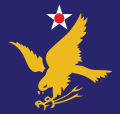446th Operations Group  | |
|---|---|
 C-17 Globemaster III from the 446th and 62nd Airlift Wings loading cargo at McMurdo Station, Antarctica during Operation Deep Freeze | |
| Active | 1943–1945; 1948–1951; 1955–1959; 1992–present |
| Country | |
| Branch | |
| Role | Airlift |
| Garrison/HQ | McChord AFB, Washington |
| Nickname(s) | Bungay Buckaroos (World War II) [1] [a] |
| Motto(s) | Voler Venger Vaincre (French for 'Fly, Avenge, Conquer') (World War II) [2] |
| Engagements | European theater of World War II |
| Decorations | Air Force Meritorious Unit Award |
| Commanders | |
| Ceremonial chief | Air Force Reserve Command |
| Insignia | |
| 446th Operations Group [b] |  |
| 446th Bombardment Group emblem [4] |  |
| World War II tail code [4] | Circle H |
The 446th Operations Group is a United States Air Force Reserve unit assigned to the 446th Airlift Wing. It is stationed at McChord Air Force Base, Washington.
Contents
- Overview
- History
- World War II
- Reserve operations
- Lineage
- Assignments
- Components
- Stations
- Aircraft assigned
- Awards and campaigns
- Notes
- References
- Bibliography
- Further reading
- External links
The group was first activated as the 446th Bombardment Group and served in combat as an Eighth Air Force B-24 Liberator unit in England. In 1944 the group led Eighth Air Force and the 2d Bombardment Division on the first heavy bomber mission of D-Day. [c] The group's 706th Bombardment Squadron flew 62 consecutive missions and 707th Bombardment Squadron had 68 missions without loss. After V-E Day the group returned to the United States, where it was inactivated in August 1945.
The group was activated again in the Air Force Reserve in 1948 at Carswell Air Force Base, Texas. It trained alongside the active duty 7th Bombardment Group until 1951 when it was called to active duty so that its personnel could be used as fillers for other units, then it was inactivated.
In 1955 the group was again activated in the reserve as the 446th Troop Carrier Group at Ellington Air Force Base, Texas. It was inactivated in 1959 when Continental Air Command reorganized its wings under the dual deputy model, which eliminated operational and maintenance group headquarters.
The group was activated a fourth time in 1992 as the command element for the flying units of the 446th Airlift Wing as reserve units reorganized under the Objective Wing organizational model.





